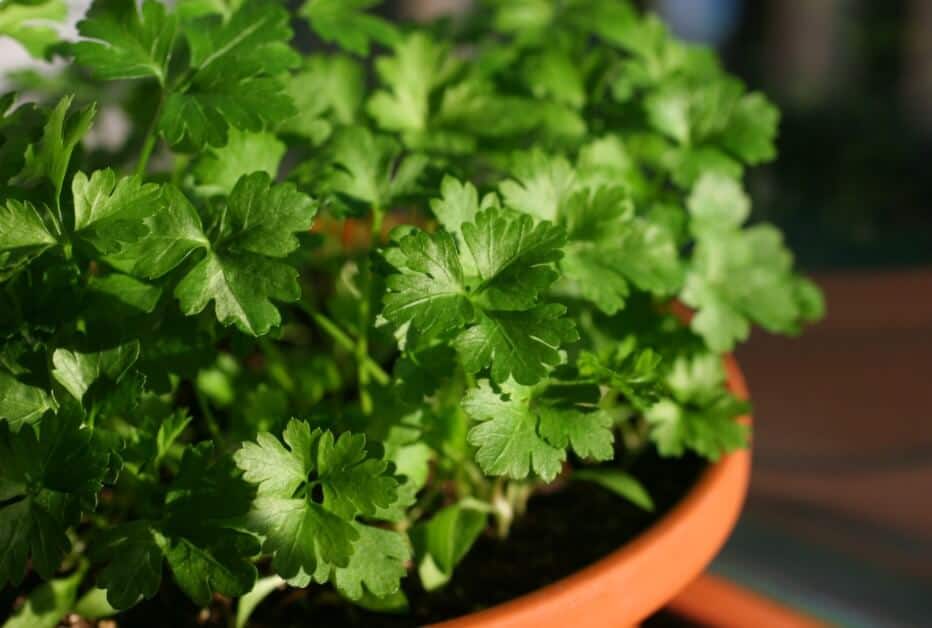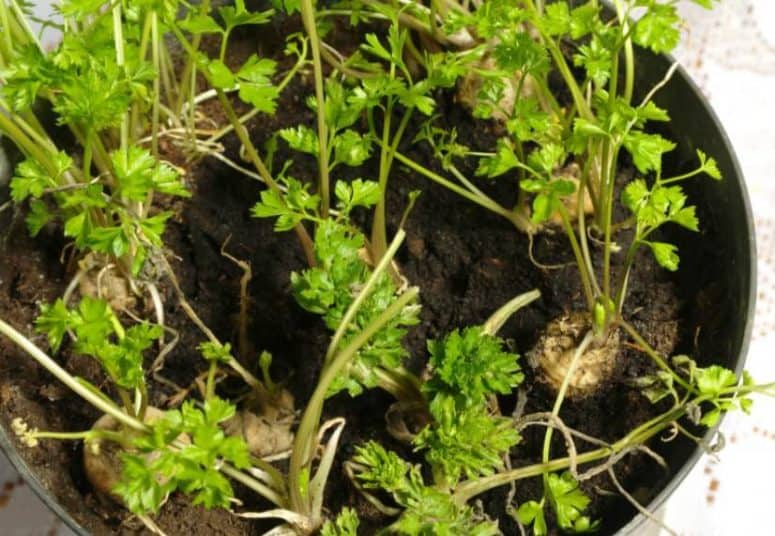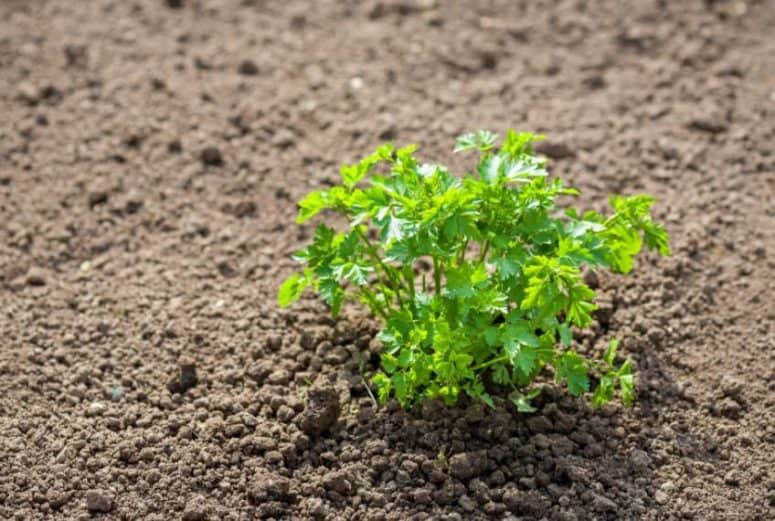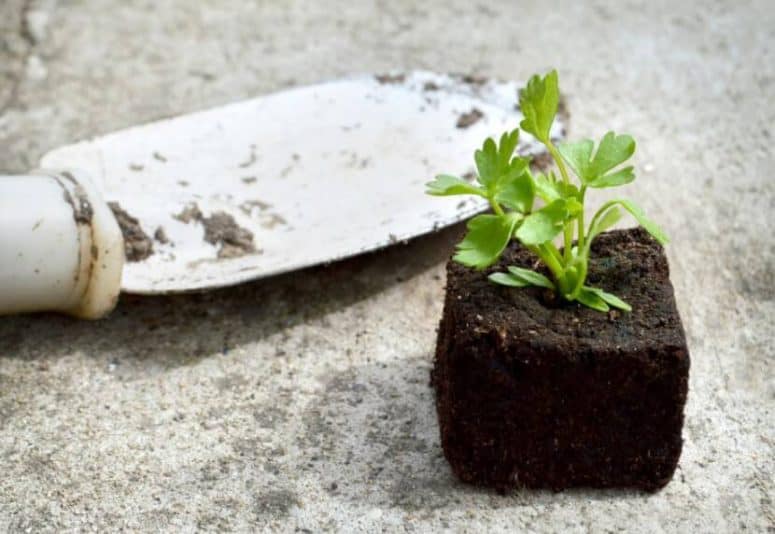How to Grow Parsley At Home (A Beginner Guide)

What’s the best garnish for a dish of all time? Yes, parsley! Parsley is a biennial herb that is usually grown as an annual one. Belongs to the celery family, parsley is also one of the most popular herbs for culinary purposes.
The taste of parsley is very fresh and bright that your soup will taste better even with less salt. The freshness of parsley makes it match salad and sauces very well.
The first thing you can notice in parsley is the fresh green leaves from it. The leaves are pointed and somehow look like mini maple leaves.
There are some different kinds of parsley. The two most-known ones are the curly parsley and flat parsley. Both flat and curly parsley are equally delicious in flavor and vibrant in color. However, most cooks prefer to use flat parsley since it is easier to chop the flat ones.
Growing parsley in your house is going to benefit you because parsley is very versatile in food. However, parsley offers you more than just delicacy in taste.
Parsley contains vitamin A, vitamin C, and vitamin K, excellent antioxidants for body immunity. What’s better than when deliciousness meets health advantages?
Also, growing parsley won’t be a big issue, even for a green thumb beginner. Parsley is one of the easiest herbs to grow. Here is the ultimate guide on how to grow parsley at home.
How to Grow Parsley
There are some different types of parsley, but there are just three most common ways to grow it. You can either plant parsley from seed or planting it by cuttings. Planting parsley from seeds could save your money and grow even more bushes of parsley. Growing it by cuttings could save more time and usually more preferable since it requires less treatment without having to wait for germination like seeds.
If you choose to grow it from seed, notice that the seed takes a couple of time to germinate. Also, you are going to need a fish emulsion fertilizer to cultivate the seed.
Meanwhile, growing it from cutting and layering means producing the stem from the previously grown parsley plants that are usually available in nurseries.
If you want to have a more comfortable and faster way, you’d better grow parsley from cuttings. It is possible to grow parsley from seed, but it might be hard to establish, especially for beginners.
The surrounding elements, a little water, good soil, or some monthly fertilizer, and you should be fine. Keep harvesting, and the plant will keep sending out new leaves.
Indoor or Outdoor?
Parsley is a flexible herb to plant. It is all up to you whether you want to grow it indoors or have enough garden to plant your parsley outdoors.
Planting parsley outdoor is very easy. You can sow the seed on the prepared soil by seeding, which is better to reach 50 degrees in temperature. After that, you should wait for five to six weeks for the seeds to germinate.
Parsley is like most herbs. It could be planted very well indoors in a pot or container. When growing parsley indoors, you need to know when to keep the box warm in a sunny spot like a transparent window.
You can produce the best parsley by mixing its scent or flavor with the plants next to it. Growing parsley next to rose bushes in the garden could get you more fragrant blossoms of the parsley’s rose and scent. Planting parsley next to acidic veggies like tomato could also be a great match.
Soil
Parsley loves loamy and moist soil, just like most herbs do. However, you need to pay attention to the soil’s pH since you will grow and take the leaves to enjoy. Parsley grows best in neutral soil, which is in a range of pH 6.0 to 7.0.
Take note that you should prepare your soil packed with nutrients before planting or growing parsley in the first place. Mix the soil with aged compost or other rich organic matter for better results.
The last one, make sure always to check the soil regularly. These leafy herbs enjoy consistent moisture. So, check the soil regularly and water when the top inches become dry.
Light
Most herbs like full sun for their growth, and so does parsley. Parsley grows well in full sun or part sun exposure. If you grow parsley outdoor with full access to sunlight every day, you should be fine.
As for indoor planting, make sure to grow it in a container you place in the house’s sunniest spot.
Yes, sunlight access from windows is good enough to grow parsley, but the plants might still grow slower than growing outdoor. That is because the window glass could decrease the amount of light for your parsley plants.
Pro-tip, use a fluorescent light to keep the seedlings in the container grow. Place it at least two inches above the leaves at all cause.
Water
Basic herb rules applied, never waterlogged the soil unless you want mildew to start appearing. Water your parsley with water-soluble plant food to produce prolific parsley leaves.
Besides, parsley is pretty adaptable in that it could handle drought soil more than overwater soil.
However, you still have to moist the soil as soon as you realize it is dried out. Never let the soil over logged, but never let it over drought as well.
Temperature
Parsley can stand drought and cold climate like winter. Nevertheless, parsley could turn into a bitter herb when growing in a too cold temperature.
Fertilizer
Fertilize your parsley regularly with a couple of inches of organic matter like well-rotted manure or aged compost.
Those types of fertilizer would give the soil nutrients and nitrogen, which could keep the soil moisture.
Harvesting
You can start harvesting your parsley when it has grown bushy about 6 inches tall. Harvest the parsley by cutting the whole stems from the base of the plant to trigger more growth. Just remember not to cut more than 1/3 of the leaves at a time.
Troubleshooting the Pest
Some herbs, including fennel, dill, and parsley, are caterpillar’s favorite. That to be in the place of where swallowtail butterfly is treasured. Although those worms are eating much of the parsley leaves, they won’t kill it.
Therefore, some people plant enough parsley to see beautiful flying butterflies in the late summer or fall.
Planting parsley outside is good for attracting butterflies.
What you need to worry about is the whitefly. That is a serious pest for the parsley. You can get rid of whitefly by spraying identical soap under the leaves thoroughly.
Conclusion
Parsley is a pretty versatile herb, either in water or temperature. Water it regularly once dried out and do not let it over drought and overwatered are the two most essential things in growing herbs, either from seeds or cuttings.
Fertilize the parsley with organic matter or aged compost for better results.


